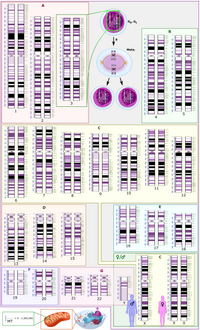
Photo from wikipedia
The evolutionary and functional features of RNA editing are well studied in mammals, cephalopods, and insects, but not in birds. Here, we integrated transcriptomic and whole-genomic analyses to exhaustively characterize… Click to show full abstract
The evolutionary and functional features of RNA editing are well studied in mammals, cephalopods, and insects, but not in birds. Here, we integrated transcriptomic and whole-genomic analyses to exhaustively characterize the expansive repertoire of adenosine-to-inosine (A-to-I) RNA editing sites (RESs) in the chicken. In addition, we investigated the evolutionary status of the chicken editome as a potential mechanism of domestication. We detected the lowest editing level in the liver of chickens, compared to muscles in humans, and found higher editing activity and specificity in the brain than in non-neural tissues, consistent with the brain’s functional complexity. To a certain extent, specific editing activity may account for the specific functions of tissues. Our results also revealed that sequences critical to RES secondary structures remained conserved within avian evolution. Furthermore, the RNA editome was shaped by purifying selection during chicken domestication and most RESs may have served as a selection pool for a few functional RESs involved in chicken domestication, including evolution of nervous and immune systems. Regulation of RNA editing in chickens by adenosine deaminase acting on RNA (ADAR) enzymes may be affected by non-ADAR factors whose expression levels changed widely after ADAR knockdown. Collectively, we provide comprehensive lists of candidate RESs and non-ADAR-editing regulators in the chicken, thus contributing to our current understanding of the functions and evolution of RNA editing in animals.
Journal Title: Zoological Research
Year Published: 2022
Link to full text (if available)
Share on Social Media: Sign Up to like & get
recommendations!